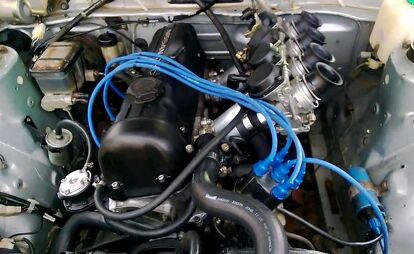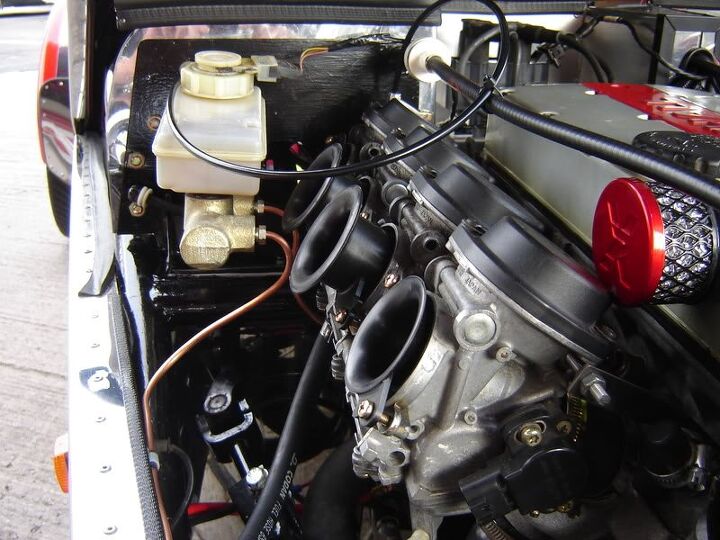Trizzle's Take – When Cars And Bikes Collide

No, not like that
My taste in vehicles is a little strange. When it comes to bikes, I dig the latest and the greatest. However, when it comes to cars, give me the old stuff. In fact, besides my beater pick-up truck I use to haul bikes around, and my wife’s cushy sedan, my four-wheel collection consists of not one, but two, Datsun 510s. Both with only two doors. Both built in 1971. And both not currently running. Sigh.
What does this have to do with motorcycles? Well, the thing with old cars (and bikes) is sometimes you have to get crafty and creative to keep them on the road. Parts are becoming increasingly difficult to come by, and when you do find that special something, it can often be crazy expensive.
Every now and again, I like to take a peek at the forums to see if any new or innovative ideas have taken hold in the 510 world. Usually the questions I see are simply variations on the standard questions answered a million times in the F.A.Q. section (and no, you can’t get 400 hp from a 1600cc SOHC production engine built in the 1970s, spend under $2000 and drive it to Maine and back. Stop asking.)
However, this particular time my browsing brought me to an interesting topic.The Datsun 510, like many cars from the era, is carbureted. Mine currently sports a pair of sidedraft Mikuni carbs, and though the company is still alive and well, carb development in the automotive sector died in the 1980s. Meanwhile, motorcycles (and snowmobiles, ATVs, etc.) miraculously hung on to carburetors into the new millenium, with the help of companies like Mikuni advancing the technology along the way. Best of all, now that EFI is firmly rooted in the bike world, used carbs are plentiful and cheap. Are you seeing what I’m getting at here?
Imagine my surprise to see classic car owners turning to motorcycle carburetors as cheap, relatively easy, and often better alternatives to the antiquated stock units that originally came with their car. Carbs like the Mikunis I currently have can get out of tune easily, and don’t flow nearly as well as modern bike units. There’s some fabrication work that needs to be done to fit bike carbs to cars – mainly creating or modifying an intake manifold – but old car owners should be used to fabbing up a part or two to keep their cars running.
The benefits of fitting bike carbs to cars are numerous. Besides the inexpensive parts availability of old motorcycle carburetors, the more modern and more efficient design of constant velocity (CV) carbs results in better throttle response and drivability. Assuming the fuel metering – which needs to be adjusted as the carb transitions from a life on the vehicle it was intended for to a completely foreign one – is perfected, the result will be better fuel economy as well. Another benefit is the smaller physical dimensions of a bike carb compared to many car units. For those who like to stuff big engines into small cars, utilizing available space is important.
For my 510, as well as other vintage four-cylinder Japanese cars, a nice street setup involves a 40mm sidedraft carb (45mm for a hi-performance engine). For reference, the 1998 – 2001 Yamaha R1 carbs feature a 42mm body with a 40mm choke. Meaning, right out of the box, the R1 units are in the ballpark. Only the jetting would need to be fine tuned. Certain Harley-Davidson units are also said to work but are not recommended since the V-Twin only ran one carb, meaning, depending on engine application, at least another unit would have to be sourced, mated together on an intake manifold and synced together. The extra effort simply isn’t worth it.
I personally haven’t driven a car with motorcycle carbs fitted to it, but considering the fuel economy benefits alone, the thought of getting similar performance as my current setup while using less fuel is intriguing. Besides, it’s a clever way to combine my two-wheel and four-wheel worlds together.
Generally speaking, I’m used to seeing the latest car technologies trickle down into the bike world – EFI, ABS, cruise control, traction control, etc. – but I can’t remember a time when the sharing of technology has worked the other way. I’m delighted to see old bike parts can be put to use on even older cars.
However, come to think of it, carburetors themselves are a dated technology. Maybe my next trick will be ditching the 40 year-old engine I currently have in the 510 and massaging in a tricked-out, fuel-injected Hayabusa engine!
Man, I really need to stay off the forums…

Troy's been riding motorcycles and writing about them since 2006, getting his start at Rider Magazine. From there, he moved to Sport Rider Magazine before finally landing at Motorcycle.com in 2011. A lifelong gearhead who didn't fully immerse himself in motorcycles until his teenage years, Troy's interests have always been in technology, performance, and going fast. Naturally, racing was the perfect avenue to combine all three. Troy has been racing nearly as long as he's been riding and has competed at the AMA national level. He's also won multiple club races throughout the country, culminating in a Utah Sport Bike Association championship in 2011. He has been invited as a guest instructor for the Yamaha Champions Riding School, and when he's not out riding, he's either wrenching on bikes or watching MotoGP.
More by Troy Siahaan









































Comments
Join the conversation
While this is, of course, a motorcycle website, there really is no better swap option for the 510 than something from Nissan's own SR or even RB family of engines. A friend of mine from Orlando had a 710 with an RB25 turbo and it was a hoot to ride in. However, another incredible option is the ever-available Chevy LS2...six liters is hard to beat.
Bangladesh is a country where day by day motorcycle is becoming a part of culture among the youngsters. Last year around this time Rasel Industries Ltd.
brought Lifan KP150 and this year they are going to update us with the sports version of it. It’s Lifan KPR 150 , the water cooled racing version.
See More